Partisanship and Ideology Redux
Aggregate self-identification doesn't tell us much, but the breakdowns do.
In two posts yesterday, “Partisan ID in the United States” and “Speaking of Moderates and Independents…,” Steven Taylor pointed to the complicated relationship Americans have with self-labeling their political alignments and the resulting challenges that pose for those predicting their behavior.
In the first, he pointed to new Gallup data represented in this graphic:
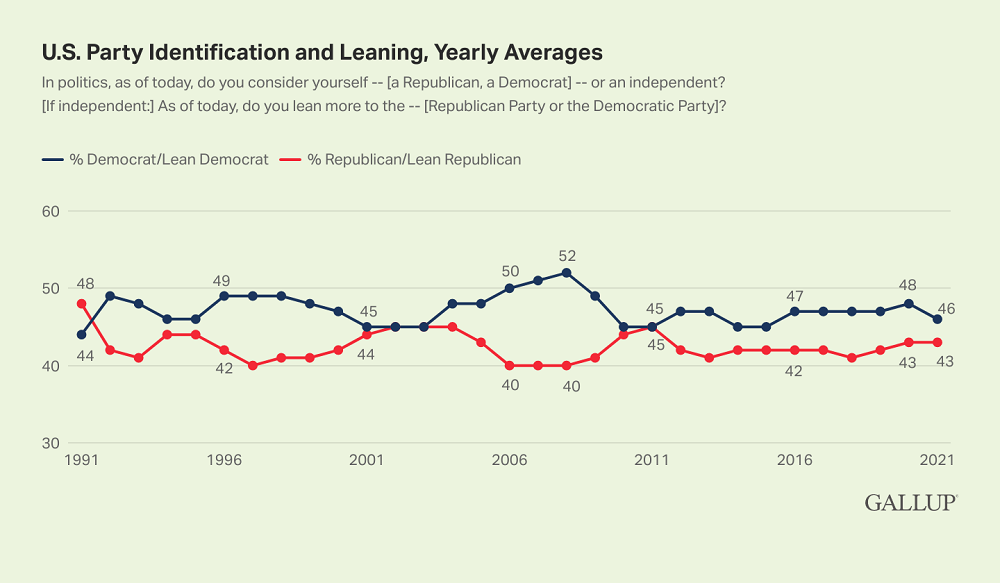
In a companion piece utilizing the same survey data, longtime Gallup analyst Lydia Saad provides this graphic:
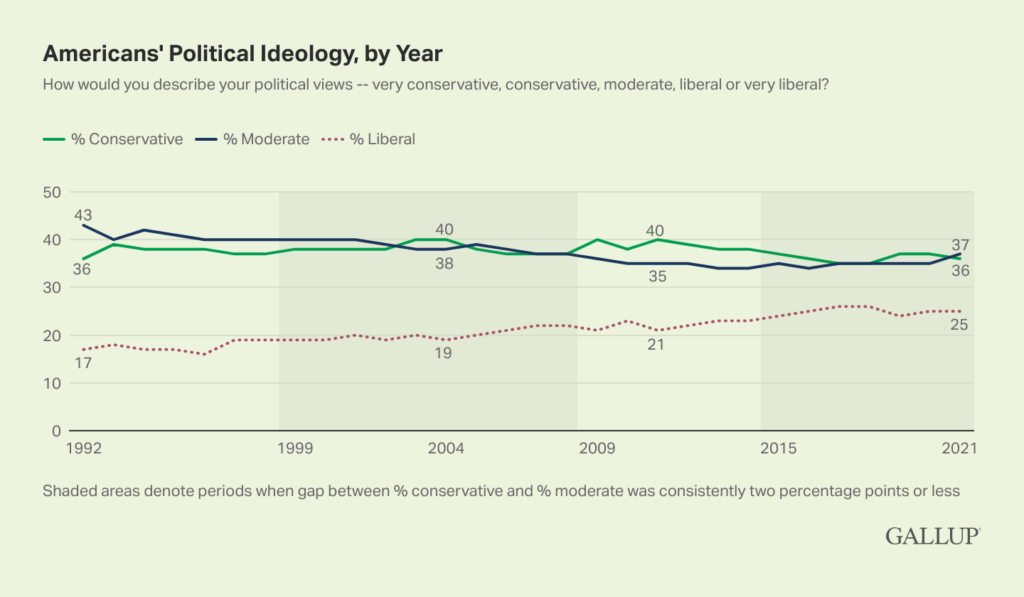
Note how little overlap there is in the trendlines. Despite fairly significant fluctuation in identification with the Republican Party, the percentage embracing the “conservative” level has been remarkably consistent. Despite more Americans calling themselves “Independent” than ever before (not reflected in the top graphic, which forces people to chose) we have become slightly less likely to embrace the “moderate” label. And while Democratic self-identification ebbs and flows, the percentage self-identifying as “liberal” has steadily increased over the past three decades.
This is consistent with Lee Drutman’s analysis in “The Moderate Middle Is A Myth,” which Steven cited in his second post. Essentially, while “conservative” has had positive associations since at least Reagan’s day, if not Nixon’s, Republicans had effectively turned “liberal” into a dirty word by Reagan’s time. Gradually, that stigma has worn off.
More importantly, though—and to one of the points Steven has been making—the labeling just doesn’t tell us much about the state of play in American politics. Indeed, if we were applying a consistent definition to “conservative,” “moderate,” and “liberal,” the American people are almost certainly more “liberal” now that they were in 1992 on a whole host of issues.
The breakdowns, though, are somewhat more telling.
Democrats are increasingly likely to self-identify as “liberal”:
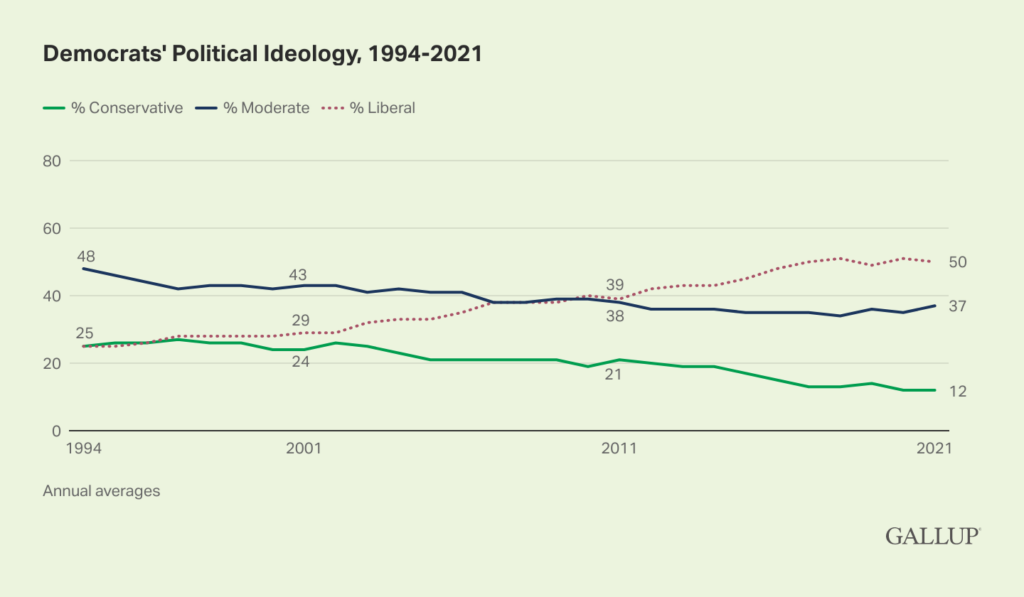
Ditto Republicans and “conservative”:
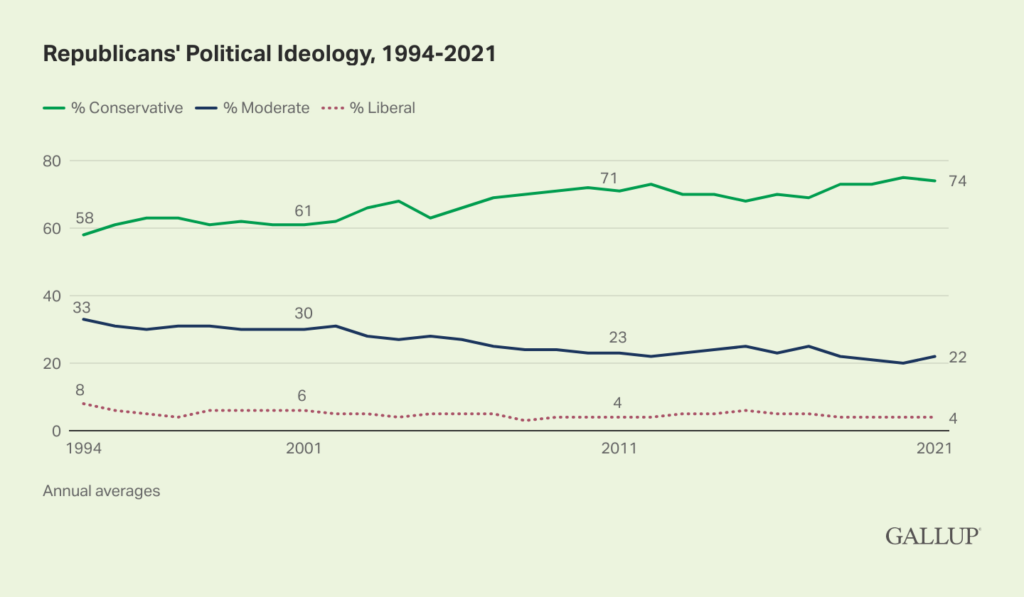
Given that this is a period of strong ideological sorting of the parties (the moderate Southern Democrat and moderate Northern Republican are essentially extinct creatures), this isn’t surprising.
The demographic sorting of ideological self-identification is roughly consistent with what we would expect by recent voting behavior:
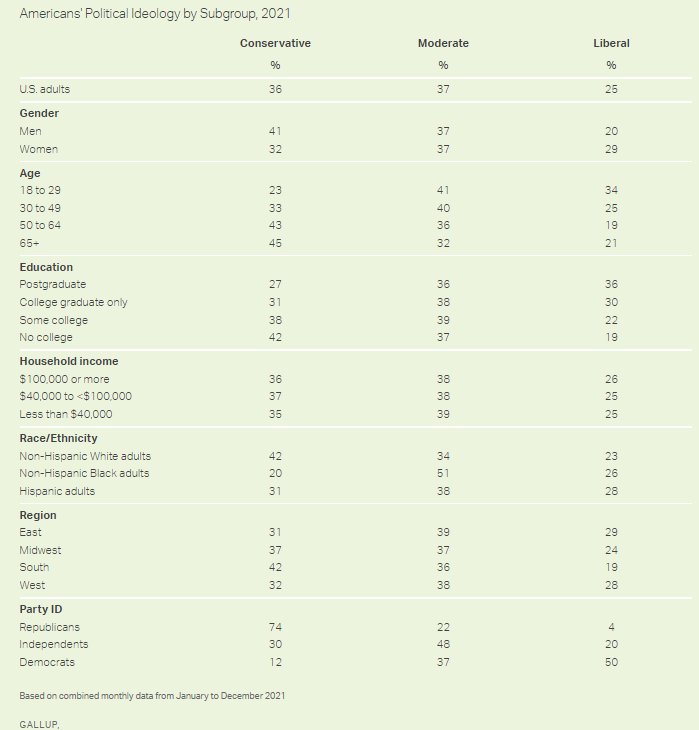



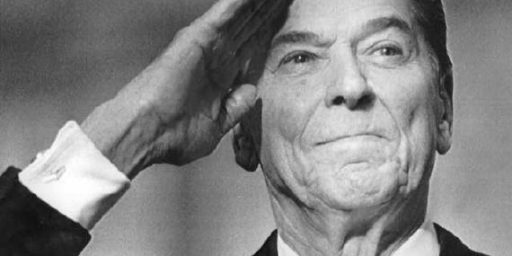

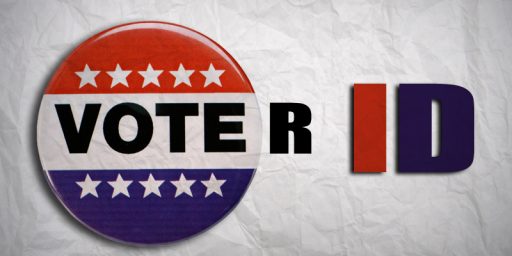
Not only is self-identification not telling us much about the state of play in American politics, I don’t think it is telling us much about ideologies either. As you note above, self-identification is telling us about branding.
I wonder how much a self-identification as a moderate, as opposed to moderate Dem or moderate Repub, simply means “I don’t like arguing about politics, and I wish everyone would behave more politely.”
OTOH:
Given the narrow margins in several states, I wonder about the effect of hundreds of thousands of Covid deaths largely concentrated in the elderly, which surely accelerated generational replacement. Obviously it’s a touchy subject, one doesn’t want to be profiting from a plague, but numbers are numbers and I’m not overly squeamish.
There have been about 12,000 Covid deaths in Wisconsin, for example. Biden won Wisconsin by 20,000 votes, so 12k voters is not nothing.
Or there’s Arizona which has lost 25,000 mostly oldsters to Covid in a state Biden won by just about half that number.
And of course, Georgia, which Biden took by 12,000 votes and which has lost 30,000 old people.
I wonder if pollsters have adjusted their models? Dr. Taylor?
@Michael Reynolds: While none of these things are fixed—Blacks went from solid Republicans to solid Democrats, we’ve seen pretty substantial shifts of college grads from GOP to Dem and vice-versa for the white working class—I think it’s quite likely that the younger generations will be very pro-Democrat unless the Republicans make a radical shift on key issues. Indeed, I’ve been arguing that for at least a decade.
I think Steven and I are really making a narrow point here: that “moderate” and “independent” as measured in these polls don’t tell us much about partisanship or issue preferences.
@Michael Reynolds:
Michael, you’re missing the point. I won’t matter how the youngn’s vote. The R plan is to rig all future elections.
@Michael Reynolds: Blacks and other minorities are more likely to die than whites from covid (controlled for vaccination status), likely due to less access to medical care. And they are also noted as vaccine hesitant communities, although they are more likely to just not get the vaccine and shut up about it rather than making a big production.
So, the demographic swing may not be as strong as you might hope.
@Sleeping Dog:
What an excellent conclusion to reach if we’re hoping to depress our turnout and surrender without a fight.
@Gustopher:
True, but you’re starting with a population of just 13%. A slightly larger piece of 13% would not, I think, offset the fact that GOPers are more vaccine resistant than other oldsters.
I mentioned the other day about how Roper Center’s historical exit polls are available online, and when you mentioned sorting, I was curious about how many self-described liberals and conservatives have voted for the “other” side historically. I remember, offhand, that in modern (21st-century) elections, there are more self-described “conservatives” voting Democrat than self-described “liberals” voting Republican. But I wanted to see how these patterns shift over time. I have included a summary of what I found at the end of this post.
One thing that stuck out for me is that there was definitely more ideological cross-voting 30-40 years ago than there is today. And it seemed to have less to do with particular elections, such as Reagan’s 1984 landslide, than I would have expected. Reagan did win a whopping 29% of liberals that year, compared with the roughly 10% of liberals who typically vote Republican in today’s elections. But Mondale won 18% of conservatives, which is higher than Biden, Hillary, or Obama in 2012, and equal to Clinton in 1992. And it didn’t look so fundamentally different from the 1976 election, when Ford won 26% of liberals and Carter won 30% of conservatives. Besides, we can’t totally dismiss the landslide years as outliers, because part of what made those landslides possible in the first place was an electorate that was a lot swingier than the one we have today.
Here’s the list:
2020: 10% of “liberals” for Trump, 14% of “conservatives” for Biden
2016: 10% of “liberals” for Trump, 16% of “conservatives” for Clinton
2012: 11% of “liberals” for Romney, 17% of “conservatives” for Obama
2008: 10% of “liberals” for McCain, 20% of “conservatives” for Obama
2004: 13% of “liberals” for Bush, 16% of “conservatives” for Kerry
2000: 13% of “liberals” for Bush, 17% of “conservatives” for Gore
1996: 12% of “liberals” for Dole, 20% of “conservatives” for Clinton
1992: 14% of “liberals” for Bush, 18% of “conservatives” for Clinton
1988: 18% of “liberals” for Bush, 19% of “conservatives” for Dukakis
1984: 29% of “liberals” for Reagan, 18% of “conservatives” for Mondale
1980: 28% of “liberals” for Reagan, 23% of “conservatives” for Carter
1976: 26% of “liberals” for Ford, 30% of “conservatives” for Carter
@Kylopod: There were still a lot more Southern Democrats in those early days. And, hell, in 1980, 1984, and 1988 California was still a reliable Republican state in Presidential voting. Carter was almost certainly more “conservative” than Ford in 1976.
I suspect that the relatively small number of conservative-identifying Democrats are mostly Black churchgoers but that’s just an educated guess.
@James Joyner:
Indeed.
Kevin Drum links to a column by Paul Waldman at WAPO to make a case that if Ds want to do better in the midterms they should be worrying less about passing BBB or anything else and making people angry at Republicans. Those of us who see what’s happening are pretty pissed already, but “moderates”, and a lot of self described Dems, aren’t. Why? Drum explains,
Rs have done better at making voters angry over imaginary CRT than Ds have over Rs actually killing people with COVID and 1/6. Rs have FOX, Ds have to rely on the supposedly liberal MSM. I don’t know what it takes to break through to “moderates”. Maybe if for midterm ads Ds run loops of the worst 1/6 video with narration that this is what my opponent wants you to vote for.
@gVOR08: We need our own Big Lie.